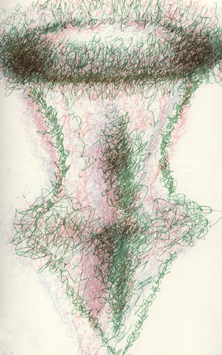
Tintinnid
I found tintinnids to be interesting because they constantly morph their shape within their shell. The shell is called Loricae and is rigid like a glass. There is a large variety of tintinnids and all swim rhythmically. They are abundant in seawater and thus easy to catch.(Dolan 2013)
The tale behind the scene goes like, this: Tintinnids are playful and flexible, we tend to research them and inquire about them in our average lives. And suite them Fashionably to our time. And some people like to protect them from being a bate to fishes, crabs, etc.
Tintinnids and their behavior.

Ciliate Zoetrope Strip Animation
According( DK Stoecker1989), using Computer analysis of feeding and swimming behavior patterns, Favella showed that when phytoplankton was present, Favella’s swimming speed decreased tremendously. Favella can detect phytoplankton through chemosensory and mechanosensory means. In another experiments, Favella was exposed to phytoflagellates. The result was that Favella was obscure and then disappeared. Favella tricks and disappears to hunt the phytoflagellates as a food source. Favella have a behavior pattern that can be monitored by the light cycle, unlike some behavior they have exhibited through photokinesis. Amazingly there has been research done on tintinnids in lake plankton, the observation was that they bloom and disappear, bloom and disappear. Just like Fashion trends. They fade in and out. They have a charm in form that we use in our Fashion, they contribute to design, in form, in style, and variety of color scheme. I find it fascinating in elements of design tintinnids are not just little sea organisms. They are very accessible to man, in research, in food chain, and a lot more.

Tintinnid in a form of vase and a petal

Tintinnid – glass formation

Sand dollar
Larvae of the tropical sand dollar have come up with system of external feeding, (Agassiz). They use their maternal as an external food source for source of nutrition, the first testing was quality of food. The second testing the timing of feeding. The third testing was culturing the larvae in sterilizing seawater. they are tactful in the way that they can survive their absence food and maintain their reservoir. But they need external food of (greater than 1µm) to build the structure or undergo metamorphosis

Crabs
Crabs are family of Grapsidae and there are plenty of them around
the intertidal communities. However not many species live in-dependent from the sea. They are certain amounts that live in Jamaica and are very special because of their adaptation to terrestrial life, which includes the only active brood-care for larvae in crabs.
Authored by: Violet Huff
Work Sited.
The biology and ecology of tintinnid ciliates:Models for Marine Plankton
Citied by John R. Dolan Published 2013 [PDF]
www.google.com
https://www.googlescholar.com/Behavioral responses of the marine tintinnid Favella sp. to phytoplankton: influence of chemical, mechanical and photic stimuli
EJ Buskey, DK Stoecker-Journal of experimental marine biology cited 1989
www.google.com
https://www.google.com/webhp?sourceid=chrome-instant&ion=1&espv=2&ie=UTF-8#q=fashion%20styles%20and%20tintinnids
Images for fashion styles and tintinnids
Chin-Leo, Gerardo P.H.D., Biological Oceanography
Ruth Hayes, M.F.A., Experimental Animation

